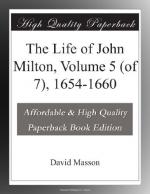Ellis were made baronets—he was out again
for an hour on the 17th; and thence till Friday the
20th he seemed so much better that Thurloe and others
thought the danger past. From the public at large
the fact of his illness had been hitherto concealed
as much as possible; and hence it may have been that
on two or three of those days of convalescence he
showed himself as usual, riding with his life-guards
in Hampton Court Park. It was on one of them,
most probably Friday the 20th, that George Fox had
that final meeting with him which he describes in his
Journal. The good but obtrusive Quaker had been
writing letters of condolence and mystical religious
advice to Lady Claypole in her illness, and had recently
sent one of mixed condolence and rebuke to Cromwell
himself; and now, not knowing of Cromwell’s own
illness, he had come to have a talk with him about
the sufferings of the Friends. “Before
I came to him, as he rode at the head of his life-guard,”
says Fox, “I saw and felt a waft of death go
forth, against him; and, when I came to him, he looked
like a dead man.” Fox, nevertheless, had
his conversation with the Protector, who told him to
come again, but does not seem to have mentioned the
inquiry he had been making, through his secretary
Mr. Malyn, about the state of Fox’s fellow-Quaker,
poor James Nayler. Next day, Saturday, Aug. 21,
when Fox went to Hampton Court Palace to keep his
appointment, he could not be admitted. Harvey,
the groom of the bedchamber, told him that his Highness
was very ill, with his physicians about him, and must
be kept quiet. That morning his distemper had
developed itself distinctly into “an ague”;
which ague proved, within the next few days, to be
of the kind called by the physicians “a bastard
tertian,” i.e. an ague with the cold and
hot shivering fits recurring most violently every
third day, but with the intervals also troublesome.
Yet it was on this first day of his ague that he signed
a warrant for a patent to make Bulstrode Whitlocke
a Viscount. Whitlocke himself, though he afterwards
declined the honour as inconvenient, is precise as
to the date. The physicians thinking the London
air better for the malady than that of Hampton Court,
his Highness was removed to Whitehall on Tuesday the
24th. That was one of the intervals of his fever,
and he seems to have come up easily enough in his coach,
and to have been quite able to take an interest in
what he found going on at Whitehall. Six days
before (Aug. 18) the Duke of Buckingham, who had been
for some time in London undisturbed, living in his
mansion of York House with his recently wedded wife,
and with Lord and Lady Fairfax in their society, had
been apprehended on the high-road some miles from
Canterbury; and, whether on the old grounds, or from
new suspicions, the Council, by a warrant issued on
the 19th, doubtless with Cromwell’s sanction
intimated from Hampton Court, had committed him to
the Tower. On the very day of Cromwell’s
return to Whitehall this business of the Duke was




